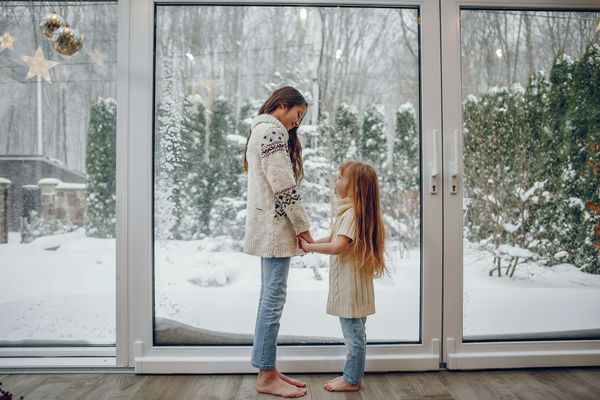The Rebates Are Officially Back with a Bang!!!
Learn More
Creating a Warm and Comfortable Home This Winter: Effective and Cheapest Ways

During the colder months, keeping your house warm is vital to prevent pipes from freezing and stay comfortable. Aside from warm air, you also need to keep the humidity in your home at a comfortable level. However, your electric bill may skyrocket as you use more heat.
What Temp Should Your House Be?
The ideal house temperature for a house is different depending on the season. In the winter, keeping the heat in your house at 20 to 22 degrees Celsius or 68 to 71.6 degrees Fahrenheit during the day may make you comfortable.
During the day, most people move around more and do their activities. So a higher temperature is necessary to compensate for the body heat we’re losing. When you sleep, your body temperature drops a few degrees, and you’re not moving around as much at night. So you don’t need the same amount of heat to keep warm.
The ideal temperature for sleeping may depend on the person’s age, metabolism, health condition, and other factors. But in general, a good range to aim for, according to doctors, is between 15.6 to 19 degrees Celsius (60 to 67 degrees Fahrenheit). On the other hand, one study says that the optimal range of sleep is around 19-21°Celcius (66.2-69.8° Fahrenheit).
The bottom line is to set the thermostat to a temperature that’s comfortable for you.
Keeping the Heat in Your Home: 5 Tips on Effective and Efficient Ways
Wondering how to make your room warmer and toasty during winter? Some methods may be more expensive, but balancing your comfort and budget is important. Here are tips on how to keep your house warm in winter:
Tip #1: Have Your Central Heating System Checked Regularly
To ensure your furnace or boiler is working efficiently, have it checked by a professional at least once a year, preferably before winter starts. This way, you can ensure that your heating system is ready to do its job when the temperature outside starts to drop.
Also, change or clean your furnace filter regularly. A dirty filter can make your furnace work harder, increasing your energy bills. It also prevents hot air circulation throughout your home, making it harder to keep warm.
Tip #2: Invest in a Good Heating System
If your current heating system is over ten years old, it might be time for an upgrade. A new and more efficient system will not only help you save money on your heating bills, but it will also make your home more comfortable.
If you want to make your room warmer, consider these factors when looking for a new system. Here are the following:
- An ENERGY STAR rating
- A high Annual Fuel Utilization Efficiency (AFUE) rating
- A good warranty
- Programmable thermostat compatibility
Tip #3: Insulate Your Home
This is probably the most efficient way to heat a living space since it helps you reduce heating costs in the long run. You may pay a lot upfront for the materials and labor, but it will be worth it as you won’t need to use so much heat to keep your living space comfortable.
A properly insulated house will warm your family in winter and add value to your home. There are various ways to insulate your home and prevent heat escape, such as:
- Attic insulation
- Wall insulation
- Sealing gaps or cracks around doors and single-glazed windows
- Weatherstripping
- Install a door sweep
Also, you have to keep in mind to keep your hot water tank and pipes insulated to prevent them from freezing during winter.
Tip #4: Use a Humidifier
Another way to make your room warmer is by using a humidifier. This will add moisture to the air, making you feel warmer. But avoid overdoing it, as too much humidity can lead to condensation, which can cause mold growth.
Tip #5: Consider Investing in a Heat Recovery Ventilator
A heat recovery ventilator (HRV) is a mechanical ventilation system that helps exchange indoor and outdoor air without heat escaping. This is an excellent way to improve your home’s air quality while still keeping it warm.
The Most Efficient & Cheapest Way to Heat A House
Most homeowners always look for cheap ways to heat a room at home. While there are various ways to do this, some methods are more effective and efficient than others.
Here are a few of the cheapest ways to keep your home warm:
Use Curtains or Blinds
This is probably one of the cheap ways to heat a room. Closing the curtains or blinds at night can help keep the heat inside your home. During the day, open them up to let the sunlight in to help warm up the room.
If you have the budget, consider getting thermal curtains. These can be a short-term solution to keep cold air from coming inside through your windows. They help trap cold air drafts behind the fabric, which can significantly affect your home’s temperature.
Use a Space Heater
If you have a cold room that’s difficult to heat or want to save energy by not heating the whole house, consider using a space heater. Just be sure to get one that’s safe and efficient. Be sure to turn it off whenever you leave the room or sleep.
Reverse the Ceiling Fan Direction
Most people use their ceiling fans to cool down their homes in the summer. But you can also use them in winter.
Reversing the direction of your ceiling fan will push warm air down, making a cold room feel warmer. Just reverse the direction of the blades so they spin clockwise. This will create an updraft, forcing warm air near the ceiling into the living space. Turn it off when you step out of the room, as it will only make it colder.
Wear Layers of Clothing
Instead of turning up the heat, you can wear a sweater or other layers of clothing to stay warm, especially on cold nights. This helps you save money and energy while still being comfortable. But this is only possible if you’re not doing a strenuous activity that makes you sweat. Some months are colder, so you may need to adjust the number of layers you wear accordingly.
To keep your feet warm, wear socks and slippers. If you have underfloor heating, an air heat pump, or a wood stove, placing a rug on the floor will also help distribute the heat more evenly.
Cook More Meals at Home
During winter, we tend to crave hot meals. So take this opportunity to cook more meals at home. Though this is not the most efficient way to heat a house, it will definitely help save you money since making home-cooked meals is usually cheaper than eating out.
Use Portable Heaters
Portable heaters are a great way to add extra warmth to a room. They’re also convenient as you can switch them from room to room as needed. Just follow the safety guidelines when using portable heaters, such as not leaving them unattended and keeping them away from flammable materials.
Use Your Fireplace
If you have a fireplace, use it. It can be a great source of heat while creating a cozy and relaxing atmosphere. Just be sure to have your chimney cleaned regularly to prevent any fires.
On the other hand, close the damper when you’re not using it. Otherwise, all the heated air will escape through the chimney. If you don’t have a fireplace, consider sealing off the chimney with an inexpensive chimney balloon. This will prevent heat loss and cold air from coming in.
Final Thoughts
The question of how to keep your house warm in winter is common among homeowners. Some require you to spend a little money and could increase your heating bill, while others are completely free. For example, curtains or blinds may be the cheapest way to heat a house, but it’s only sometimes practical. If your priority is the health and comfort of your family, investing in heating systems is a good idea.
Whatever route you decide to take, remember to take action now to enjoy a warm and comfortable home all winter long.
Terms and Conditions
- Once an initial service has been completed, the customer will be on a one-year commitment
- After the initial 12 months, the contract will be renewed on a month-to-month cadence
- If a service is completed for the next year, it automatically renews the commitment for an additional year
- Customers can cancel at any time after the 12-month initial commitment as long as the following year’s service has not been completed.
- Customers need to provide 30 days written notice in order to cancel their plan




